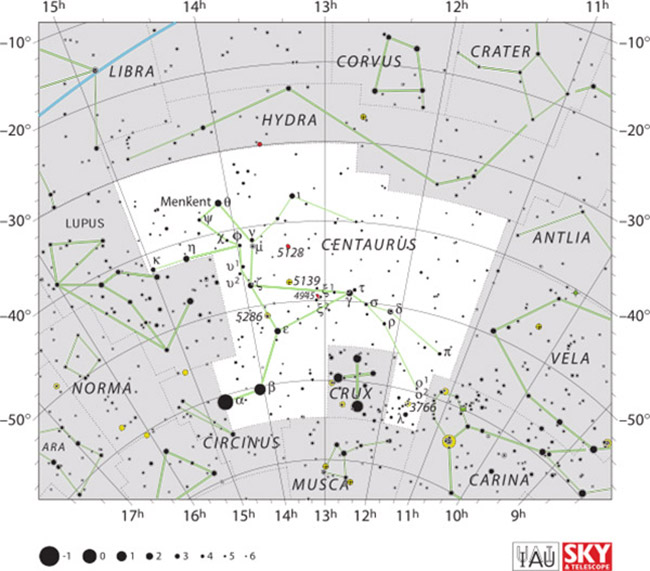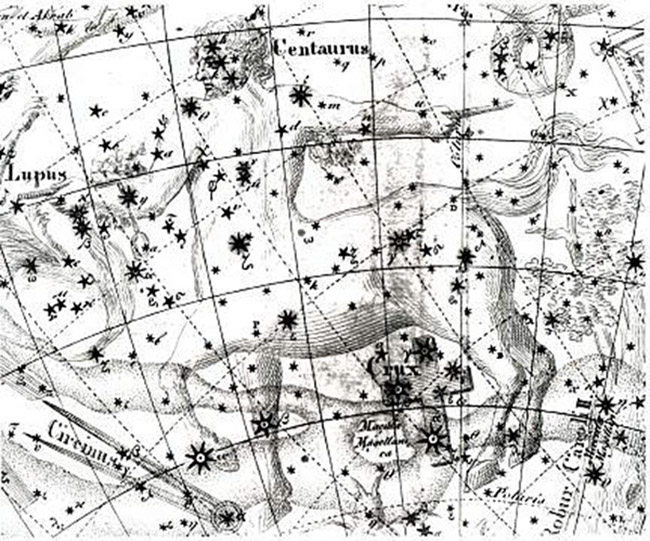Centaurus – Constellation Facts

Centaurus represents the Greek and Roman mythological beast that was half man, half horse (centaur) and also has two of the top ten brightest stars in the entire sky. This constellation can be found in the third quadrant of the Southern hemisphere and is located specifically between latitudes of +25° and -90°. Along with other constellations, Centaurus was first catalogued in the 2nd century by, Ptolemy, a Greek astronomer.
Constellation Characteristics
Centaurus is the 9th largest constellation in the night sky, occupying 1,060 square degrees. Centaurus is also neighbors with Antlia, Carina, Circinus, Crux, Hydra, Libra, Lupus, Musca and Vela. In addition, this constellation has twelve stars and eleven deep space objects, but no Messiers.

IAU and Sky & Telescope magazine (Roger Sinnott & Rick Fienberg), CC BY 3.0, via Wikimedia Commons
By IAU and Sky & Telescope magazine (Roger Sinnott & Rick Fienberg) ([1]) CC BY 3.0, via Wikimedia CommonsPlanetary Systems
Centaurus has eleven deep sky objects. Read on to discover some fascinating facts about these celestial wonders.
- Centaurus A (NGC 5128): noted as being the fifth brightest in the night sky, this galaxy is also known for being one of the closest radio galaxies to our solar system. Centaurus is also in the process of devouring a spiral galaxy which gives its periods of intense star formation (more than 100 have been observed).
- Omega Centauri (NGC 5139): this globular cluster can be seen with the naked eye and is one of the brightest and largest to be associated with the Milky Way. In fact, it is orbiting this galaxy. Omega Centauri is thought to be around 12 billion years-old and is located an estimated 15,800 light-years away.
- NGC 4945: this spiral galaxy may contain a black hole. It is located about 11.7 million light-years away and is the second brightest galaxy in the Centaurus A subgroup.
- NGC 4650A: considered a polar-ring galaxy (the gas and outer stars rotate over the poles and only about 100 are known to exist) is located an estimated 130 million light-years away.
- The Blue Planetary (NGC 3918): this is classified as a planetary nebula and the brightest one in the Southern hemisphere. It is located 4,900 light-years away and can be seen through a small telescope.
- NGC 4622: this face-on spiral galaxy has arms with tips pointing toward its disk rotation, for this reason it is also called a “backward galaxy.” NGC 4622 also has an inner trailing arm and two weak inner arms turning in the opposite direction.
- NGC 5090 and NGC 5091: this elliptical galaxy and spiral galaxy (respectively) are in the process of colliding and merging. They are located 150 million light-years away.
- NGC 4696: noted for being the brightest galaxy in the Centaurus Cluster, this elliptical galaxy is located 150 million light-years away.
- NGC 5253: this irregular galaxy is located an estimated 10.9 million light-years away. It was discovered to have one of the brightest supernovae known today.
- NGC 4603: this spiral galaxy is known for being the furthest one to contain Cepheids – stars that vary between being bright and being dense.
- NGC 5291: has been noted for being a system surrounded by a collision ring. In addition, it has galaxies that are interacting and its ring contains young star forming tidal dwarf galaxies.
Main Stars
The constellation Centaurus contains twelve main stars that make up its shape. Let’s explore them further.
- Alpha Centauri shines the brightest in the Centaurus constellation (which will be discussed later in detail).
- Proxima Centauri (Alpha Centauri C) is a red dwarf that is located only 4.24 light-years from the Sun. It is the closest star to our solar system; however, it cannot be seen with the naked eye. This star is also called, Rigil Kentaurus, which means, “the foot of the centaur” (Arabic phrase Rijl Qantūris).
- Hadar (Agena) ~ (Beta Centauri) is the tenth brightest star in the sky. It’s also a binary star classified as a blue-white giant star. Its name is derived from the Arabic language; Hadar meaning “ground” and Agena derived from Latin meaning, “knee.”
- Menkent (Haratan) ~ (Theta Centauri) is an orange K-type giant located about 60.9 light-years in distance. Its name (Menkent) is derived from the Arabic language meaning, “shoulder of the Centaur.”
- Muhlifain ~ (Gamma Centauri) is a binary in which the two stars orbit each other every 83 years. It is located 130 light-years away.
- Epsilon Centauri is a blue-white giant that is also considered a Beta Cephei type variable star, which means the luminosity of this star changes because of the pulsations on its surface.
- Eta Centauri is classified as three types; a hot class B dwarf, a Be star and also a shell star. It shows emissions in its hydrogen spectral lines and also rotates very quickly – 310 kilometers-per-second – with a rotation period of less than 24 hours.
- Alnair (Zeta Centauri) gets it name from Arabic, Nayyir Badan Qanṭūris, which means “the bright star of the body of the Centaur.” It is catalogued as a spectroscopic binary star.
- Ma Wei (Delta Centauri) is a B-type star lying about 395 light-years from Earth.
- Nu Centauri is a blue-white subgiant located 475 light-years from Earth. It is categorized as a Beta Cephei because of its changes in brightness due to surface pulsations.
- Ke Kwan (Kappa Centauri) gets its name from the Chinese language (Qí Guān sān) meaning “the Third star of the Imperial Guards.” In addition, it is a binary star situated 540 light-years away.
BPM 37093 is a white dwarf star also classified as a variable star of the ZZ Ceti type; it shows variations in its luminosity caused by non-radial gravitational wave pulsations.

Centaurus from the Uranographia of Johann Bode (1801)
Most Shining Star
Out of all the stars that make up the Centaurus constellation, none shine brighter than Alpha Centauri. It is classified as a multiply star with Alpha Centauri A being its brightest component, as well as it being the fourth individual brightest star. This component is similar to the Sun; however, it is 10 percent more massive and 250 million years older. The second brightest component, Alpha Centauri B, is a main sequence star that is similar to the Sun and shines the 21st individual brightest in the night sky.
Mythology & History
Centaurus can trace its roots back to the Babylonians. They referred to this celestial wonder as, Mul-Gud-Alim or “bison-man.” This creature was portrayed as either a four-legged bison with the head of a man or that of a human with the hind legs of a bison or bull. This creature was also thought to be with the Sun god, Utu (Shamash).
In mythology, the Romans believed Centaurus to be a half man, half horse called, a centaur. This beast was named, Chiron and his father was the Titan king, Cronus. As the story goes the king and a nymph were having an affair. One day his wife was about to catch the two of them in the act, so the king turned himself into a horse. As a result the nymph gave birth to Chiron who ended up half man, half horse.
Centaurus is a fascinating constellation, so the next time you are gazing into the night sky, be sure to search out this intriguing figuration of stars.
